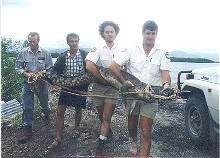| |
|
|
 An Education Kit
for Grades 5 - 7 An Education Kit
for Grades 5 - 7
|

|
| What you need |
| |
 |
Managing crocs Information Sheet (class set) |
| |
 |
Worksheet: Procedural text (class set) |
| |
 |
art paper, coloured pencils, crayons |
| |
 |
tape measures and rulers |
| |
 |
assorted texts dealing with Aboriginal totems |
| |
 |
video |
|
Activities for
teachers |
Summary |
|
KLAs |
| a Totems |
Read text and research the role of totems in Aboriginal culturest |
 |
English SoSE |
| b Graphs & measures |
Graph survival statistics and croc lengths, measure lengths using alternative measures |
Maths |
| c Procedural text |
Construct a procedural text explaining SOSE how problem crocs are managed |
Science SoSE |
| d Design a trap |
Design a trap to capture a problem croc |
Visual Arts |
| Information sheet - Explanation of various management techniques used relation to crocs. |
|
|
What you do
a) Totems
- Show the video and ask students to read the Managing Crocs Information Sheet. Discuss any local examples of croc management that students may know of.
- Invite an Elder or key indigenous community person in to speak to your class about totems, how they might help to 'manage' or 'conserve' animals. For example, make use of your library resources, such as Kakadu Man (see Additional Resources) to research further about the roles of totems.
- Discuss the points of view of the Aboriginal Elder, the ex-croc hunter, and views expressed on the video. How do peoples' views of the land (and its animals and plants) differ?
b) Graphs and measures
- Discuss the low survival rate and the various causes of mortality of baby crocs.
- Ask students to construct a pie graph to illustrate the statistics of croc survival in the wild from Mark Read's interview.
- Discuss the sizes of crocs from Clayton Enoch's interview. Ask students to construct bar graphs to illustrate the maximum sizes
- Provide students with tape measures and get them to work in small groups. Ask them to find equal measures to describe the maximum lengths of male and female crocs. Give them examples, ie. number of desks end to end, number of grade 6 students footsteps, number of chairs side by side, number of pencils end to end, etc.
|

Clayton Enoch (second from right)
and wildlife rangers capture a
crocodile for removal.
(courtesy Cairns Post) |
- Compare each group's examples. Write up your results on posters for display.
c) Procedural texts
- Read Clayton Enoch's interview again.
- Provide students with the worksheet, 'Procedural text', and ask students to complete the worksheet using note form only.
- Use the worksheet as a basis for constructing a procedural text either as a whole class, in groups or on an individual basis.
d) Design a trap
- Discuss the reasons for trapping crocs. Brainstorm as a class to list the factors that should be consid- ered when designing a croc trap. Factors may include length of the animal, safety measures to ensure the animal does not drown or injure itself once it has been caught, securing the trap to ensure it cannot be removed by the croc, strength of the materials, type and positioning of the bait and ways in which the trapped animal can be removed and relocated.
- Work in groups or on an individual basis. Label the completed designs and, where appropriate, ask students to write short captions giving a brief explanation of what each feature is for and how it works.
- Ask students to give oral presenta- tions about their designs.
Extension
- Imagine yourself as a croc hunter on the Cape in the 1950s. Write about the capture of a large croc from a croc hunter's point of view. Refer to Crocodile Men (see Additional Resources and the video) for more ideas. This could be written in the form of a diary or imaginative account. Invite an ex-croc hunter or ranger into your classroom to speak to the students. Provide students with the opportunity to interview the hunter or ranger about capturing crocs.
- Write an imaginative account from the crocodiles point of view about being caught in a trap. Read similar narratives first (see Additional Resources - Dabu the Baby Dugong).
 |
© Copyright 2000
Marine Education Society of Australasia
Wildlife Preservation Society of Qld |
 |
crocs on show |
|
|
|
|
|